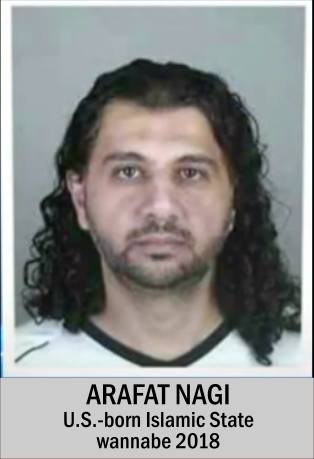| America, for all its imperfections, is not fertile ground for producing jihadist terrorists |
"Home-grown" terror cells remain a concern of US law officers, who cite several disrupted plots since 9/11. But the suspects' unsophisticated planning and tiny numbers have led some security analysts to conclude that America, for all its imperfections, is not fertile ground for producing jihadist terrorists.
To understand why, experts point to people like Omar Jaber, an AmeriCorps volunteer; Tarek Radwan, a human rights advocate; and Hala Kotb, a consultant on Middle East affairs. They are the face of young Muslim-Americans today - educated, motivated, and integrated into society - and their voices help explain how the nation's history of inclusion has helped to defuse sparks of Islamist extremism.
"American society is more into the whole assimilation aspect of it," says New York-born Mr. Jaber. "In America, it's a lot easier to practice our religion without complications."
| it's impossible to ignore the stark contrast between the lives of Muslims in European countries where bombings have occurred and those of Muslims in America |
It's impossible to pinpoint the factors that produce home-grown terrorists, analysts say. But it's also impossible to ignore the stark contrast between the lives of Muslims in European countries where bombings have occurred and those of Muslims in America.
| People come to this country and they like it. They don't view it as the belly of the beast. With very few exceptions, you don't see the bitter enclaves that you have in Europe |
"What we have here among Muslim-Americans is a very conservative success ethic," says John Zogby, president of Zogby International in Utica, N.Y., whose polling firm has surveyed the Muslim-American community. "People come to this country and they like it. They don't view it as the belly of the beast. With very few exceptions, you don't see the bitter enclaves that you have in Europe."
Part of what so shocked Spain about the Madrid train bombers, and then Britain after the London subway and bus bombings in July 2005, was that most of the perpetrators were native sons. In each case, the young men, allegedly inspired by Al Qaeda ideology, came from poorer neighborhoods heavy on immigrants. (By contrast, a plot foiled in August to blow up airplanes over the Atlantic involved suspects from leafy, middle- and upper-middle-class neighborhoods in Britain.)
America, too, has poorer neighborhoods with large Muslim concentrations, but they tend to be interspersed with other ethnic groups and better assimilated into society. Another difference, some suggest, is the general profile of Muslims who have come to the US and raised their families here.
Most Muslim immigrants came to America for educational or business opportunities and from educated, middle-class families in their home countries, according to an analysis by Peter Skerry of Boston College and the Brookings Institution. In Europe, the majority came to work in factory jobs and often from poorer areas at home.
European Muslims today live primarily in isolated, low-income enclaves where opportunities for good jobs and a good education are limited. In the US, 95 percent of Muslim-Americans are high school graduates, according to "Muslims in the Public Square," a Zogby International survey in 2004. Almost 60 percent are college graduates, and Muslims are thriving economically around the country. Sixty-nine percent of adults make more than $35,000 a year, and one-third earn more than $75,000, the survey showed.
In Britain, by contrast, two-thirds of Muslims live in low-income households, according to British census data. Three-quarters of those households are overcrowded. British Muslims' jobless rate is 15 percent - three times higher than in the general population. For young Muslims between 16 and 24, the jobless rate is higher: 17.5 percent.
"The culture is qualitatively different [in the American Muslim community] from what we've seen from public information from Europe, and that actually says very positive things about our society," says Jonathan Winer, a terrorism expert in Washington. "We don't have large populations of immigrants with a generation sitting around semi-employed and deeply frustrated. That's a gigantic difference."
"My theory as to why we haven't found any [homegrown Islamist terrorist cells] is because there aren't very many of them.... They aren't the diabolical, capable, and inventive people envisioned by most politicians and people in the terrorism industry," says John Mueller, a political scientist at Ohio State University. "The danger is that we've wasted an enormous amount of money with all of the wiretaps [and] investigations, and diverted two-thirds of the FBI from criminal work to terrorism work."
The FBI calls such conclusions "uninformed," citing alleged plots by radicalized US citizens. The most notable was the case of the Lackawanna Six, so named for the six Yemeni-Americans from Lackawanna, N.Y., who went to Al Qaeda training camps in the spring of 2001.
| The people who make these claims [about threats being exaggerated] are never the ones responsible for preventing these attacks |
"The people who make these claims [about threats being exaggerated] are never the ones responsible for preventing these attacks," says John Miller, the FBI's assistant director of public affairs. "The point is that if you're the dead guy, or you're a family member of one of those guys, all you know is that you wanted someone to develop the intelligence and take the actions to prevent it."
Still, a lack of public evidence pointing to extensive Islamist extremism in the US is leading a small but growing number of experts to agree with Professor Meuller's assessment. Like Meuller, though, they add a cautionary note.
"There's not zero threat in any community, but it is good news and we have to hope that reflects an underlying reality that [homegrown extremist cells] don't exist here," says Jonathan Winer, a terrorism expert in Washington. "You've always got lone nuts in every imaginable ethnic group grabbing every imaginable ideology to justify terrorism." |
 She describes herself as 'progressive' and is keenly pro-choice and pro-LGBTQ rights. Hochul is well-liked upstate, where Cuomo's popularity has evaporated. 'She is probably one of the most down-to-earth people that you could ever meet,' Assemblywoman Karen McMahon told Politico recently. 'She’s gone to great heights in government, yet one-to-one, she is so accessible and so warm and just a very generous person. She’s always able to help — particularly women, too.'
She describes herself as 'progressive' and is keenly pro-choice and pro-LGBTQ rights. Hochul is well-liked upstate, where Cuomo's popularity has evaporated. 'She is probably one of the most down-to-earth people that you could ever meet,' Assemblywoman Karen McMahon told Politico recently. 'She’s gone to great heights in government, yet one-to-one, she is so accessible and so warm and just a very generous person. She’s always able to help — particularly women, too.' 

 [SPECTRUMLOCALNEWS] A Lackawanna man has pleaded guilty to working with the
[SPECTRUMLOCALNEWS] A Lackawanna man has pleaded guilty to working with the 
 One of the FBI's most-sought terrorism suspects has surrendered to authorities in Yemen, more than a year after tunneling out of a prison there, a spokesman for the Yemeni Embassy said Monday.
One of the FBI's most-sought terrorism suspects has surrendered to authorities in Yemen, more than a year after tunneling out of a prison there, a spokesman for the Yemeni Embassy said Monday.  A key piece of evidence in the case against alleged terrorism operative
A key piece of evidence in the case against alleged terrorism operative  BUFFALO, N.Y. A man was sentenced to five years in prison Thursday for running an unlicensed money-transfer business that sent $5 million to Yemen. Mohamed Albanna of Lackawanna arranged the transfers from his Buffalo cigarette and candy wholesale business from 1999 to 2002.
BUFFALO, N.Y. A man was sentenced to five years in prison Thursday for running an unlicensed money-transfer business that sent $5 million to Yemen. Mohamed Albanna of Lackawanna arranged the transfers from his Buffalo cigarette and candy wholesale business from 1999 to 2002.